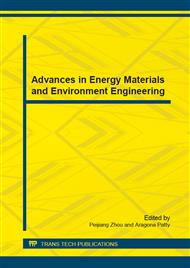[1]
Zhang Daiyan, Peng Jun, Gu Yanling and Leng yan, Experimental study on threshold pressure gradient of heavy oil reservoir [J], Xinjiang petroleum geology, 2012, 33(2): 201-204.
Google Scholar
[2]
Huang Yanzhang, Seepage mechanism in low permeability reservoir [M]. Beijing: Petroleum Industry Press, (1998).
Google Scholar
[3]
Li Chuanliang, Is a starting pressure gradient necessary for flow in porous media? [J], Acta Pretrolei Sinica, 2010, 31(5): 867-870.
Google Scholar
[4]
Miller R.J. et al. Threshold gradient for water flow in clay system, Proc. Soil. Sci. Soc. Am, 1963, 27: 606-609.
Google Scholar
[5]
Yan Qinglai, He Qiuxuan, Wei Ligang et al. Experimental study on single-phase fluid flow characteristics in low permeability reservoir [J], Journal of Xi'an Shiyou University, 1990, 5(2): 1-4.
Google Scholar
[6]
Huang Yanzhang. Nonlinear percolation feature in low permeability reservoir [J]. Special Oil and Gas Reservoirs, 1997, 4(1): 9-14.
Google Scholar
[7]
Xiao Luchuan, Zhen Li, Zheng Yan et al. Study on non-Darcy seepage characteristic in ultra-low permeability reservoir [J]. Petroleum Geology & Oilfield Development in Daqing. 2000, 19 (5): 27-30.
Google Scholar
[8]
D. Zaslavsky and S. lrmay, Physical Principles of Water Percolation and Seepage, UNE-SCO, Paris, (1968).
Google Scholar
[9]
PASCAL F. Consolidation with threshold gradient [J]. Inter. J. for Numerical and Analytical Methods in Geomechanics, 1980(5): 247-261.
Google Scholar
[10]
Feng Wenguang, Ge Jiali. Pressure curve dynamic characteristics of non-Darcy low-speed percolation in single and double medium. Petroleum Exploration and Development, 1986, 13(5): 52-57.
Google Scholar
[11]
Deng Yinger, Liu Ciqun. Numerical simulation of one-way unsteady seepage in low permeability porous media. Low permeability oil & gas fields, 1998, 4(3): 35-38.
Google Scholar
[12]
Richard C. Nolen Hoeksema, modulus porosity relations, Gass mann's equations, and the low frequency elastic wave response to fluids [J]. Geophysics, 2000, 65(5): 1355-1363.
DOI: 10.1190/1.1444826
Google Scholar


